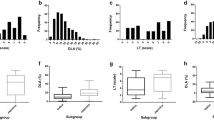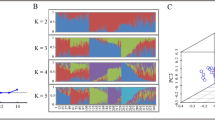Abstract
Rice blast caused by an ascomycete fungus Magnaporthe oryzae is the most devastating disease of rice worldwide. Thus understanding of the molecular mechanisms of Magnaporthe-rice interactions is crucial to devise efficient means of disease control. The availability of whole genome sequences of both M. oryzae and rice enables us to analyze their DNA polymorphisms on the genomic scale for the purpose of association genetics as well as for population genomics analysis. Studies on the association between phenotypes-DNA polymorphisms allowed us to isolate three M. oryzae AVR genes, AVR-Pia, AVR-Pii, AVR-Pik/km/kp as well as a rice R-gene, Pia. Population genomics addresses the patterns of DNA polymorphisms to identify the genomic regions under natural selection, a potentially useful tool to isolate the genes involved in plant-pathogen interactions. Recent progress in next-generation sequencing technologies predicts that these approaches would be commonly used to elucidate various host-pathogen interactions.

Similar content being viewed by others
References
Allen RL, Bitter-Eddy PD, Grenville-Briggs LJ, Meitz JC, Rehmany AP, Rose LE, Beynon JL (2004) Host-parasite coevolutionary conflict between Arabidopsis and downy mildew. Science 10:1957–1960
Ashikawa IN, Hayashi N, Yamane H, Kanamori H, Wu J, Matsumoto T, Ono K, Yano M (2008) Two adjacent nucleotide-binding site–leucine-rich repeat class genes are required to confer Pikm-specific rice blast resistance. Genetics 180:2267–2276
Berruyer R, Adreit H, Milazzo J, Gaillard S, Berger A, Dioh W, Lebrun MH, Tharreau D (2003) Identification and fine mapping of Pi33, the rice resistance gene corresponding to the Magnaporthe grisea avirulence gene ACE1. Theor Appl Genet 107:1139–1147
Böhnert HU, Fudal I, Dioh W, Tharreau D, Notteghem J, Lebrun MH (2004) A putative polyketide synthase/peptide synthetase from Magnaporthe grisea signals pathogen attack to resistant rice. Plant Cell 16:499–513
Bryan GT, Wu K-S, Farrall L, Jia Y, Hershey HP, McAdams SA, Faulk KN, Donaldson GK, Tarchini R, Valent B (2000) A single amino acid difference distinguishes resistant and susceptible alleles of the rice blast resistance gene Pi-ta. Plant Cell 12:2033–2045
Charlesworth B, Charlesworth D (2010) Elements of evolutionary genetics. Roberts and Company Publishers, Greenwood Village
Chauhan RS, Farman ML, Zhang H-B, Leong SA (2002) Genetic and physical mapping of a rice blast resistance locus, Pi-CO39(t), that corresponds to the avirulence gene AVR1-CO39 of Magnaporthe grisea. Mol Genet Genomics 267:603–612
Costanzo S, Jia Y (2010) Sequence variation at the rice blast resistance gene Pi-km locus: implications for the development of allele specific markers. Plant Sci 178:523–530
Dangl JL, Jones J (2001) Plant pathogens and integrated defence responses to infection. Nature 411:826–833
Dean RA, Talbot NJ, Ebbole DJ, Farman ML, Mitchell TK, Orbach MJ, Thon M, Kulkarni R, Xu JR, Pan H et al (2005) The genome sequence of the rice blast fungus Magnaporthe grisea. Nature 434:980–986
Dodds PN, Lawrence GJ, Catanzariti A-M, Ayliffe MA, Ellis JG (2004) The Melampsora lini AvrL567 avirulence genes are expressed in haustoria and their products are recognized inside plant cells. Plant Cell 16:755–768
Dodds PN, Lawrence GJ, Catanzariti A-M, Teh T, Wang C-I, Ayliffe MA, Kobe B, Ellis JG (2006) Direct protein interaction underlies gene-for-gene specificity and coevolution of the flax resistance genes and flax rust avirulence genes. Proc Natl Acad Sci U S A 103:8888–8893
Ellis J, Lawrence GJ, Luck JE, Dodds PN (1999) Identification of regions in alleles of the flax rust resistance gene L that determine differences in gene-for-gene specificity. Plant Cell 11:495–506
Farman ML, Eto Y, Nakao T, Tosa Y, Nakayashiki H, Mayama S, Leong SA (2002) Analysis of the structure of the AVR1-CO39 avirulence locus in virulent rice-infecting isolates of Magnaporthe grisea. Mol Plant-Microb Interact 15:6–16
Flor HH (1956) The complementary genic systems in flax and flax rust. Adv Genet 8:29–54
Gillespie JH (1994) The causes of molecular evolution. Oxford University Press, Oxford
Gillespie JH (1998) Population genetics. A concise guide. The Johns Hopkins University Press, Maryland
Hogenhout SA, van der Hoorn RAL, Terauchi R, Kamoun S (2009) Emerging concepts in effector biology of plant-associated organisms. Mol Plant-Microb Interact 22:115–122
International Rice Genome Sequencing Project (2005) The map-based sequence of the rice genome. Nature 436:793–800
Jia Y, McAdams SA, Bryan GT, Hershey B, Valent B (2000) Direct interaction of resistance gene and avirulence gene products confers rice blast resistance. EMBO J 19:4004–4014
Kamoun S (2007) Groovy times: filamentous pathogen effectors revealed. Curr Opin Plant Biol 10:358–365
Kang S, Sweigard JA, Valent B (1995) The PWL host specificity gene family in the blast fungus Magnaporthe grisea. Mol Plant-Microb Interact 8:939–948
Kimura M (1983) The neutral theory of molecular evolution. Cambridge University Press, Cambridge
Kinoshita T (1998) Report from coordinator Linkage mapping using mutant genes in rice. In: Sano Y, Kush GS (eds) Rice genetics newsletter vol. 15. A Publication of the Rice Genetics Cooperative, Japan, pp 13–74
Lazzaro BP (2008) Natural selection on the Drosophila antimicrobial immune system. Curr Opin Microbiol 11:284–289
Lee SA, Wormsley S, Kamoun S, Lee AFS, Joiner K, Wong B (2003) An analysis of the Candida albicans genome database for soluble secreted proteins using computer-based prediction algorithms. Yeast 20:595–610
Lee SK, Song M-Y, Seo Y-S, Kim H-K, Ko S, Cao PJ, Suh P-J, Yi G, Roh J-H, Lee S, An G, Hahn T-R, Wang G-L, Ronald P, Jeon J-S (2009) Rice Pi5-mediated resistance to Magnaporthe oryzae requires the presence of two coiled-coil-nucleotide-binding-leucine-rich repeat genes. Genetics 181:1627–1638
Li W, Wang B, Wu J, Lu G, Hu Y, Zhang X, Zhang Z, Zhao Q, Feng Q, Zhang H et al (2009) The Magnaporthe oryzae avirulence gene AvrPiz-t encodes a predicted secreted protein that triggers the immunity in rice mediated by the blast resistance gene Piz-t. Mol Plant-Microb Interact 22:411–420
Liu J, Wang X, Mitchell T, Hu Y, Liu X, Dai L, Wang G-L (2010) Recent progress and understanding of the molecular mechanisms of the rice-Magnaporthe oryzae interaction. Mol Plant Pathol 211:419–427
Loutre C, Wicker T, Travella S, Galli P, Sofield S et al (2009) Two different CC-NBS-LRR genes are required for Lr10-mediated leaf rust resistance in tetraploid and hexaploid what. Plant J 60:1043–1054
Miki S, Matsui K, Kito H, Otsuka K, Ashizawa T, Yasuda N, Fukiya S, Sato J, Hirayae K, Fujita Y et al (2009) Molecular cloning and characterization of the AVR-Pia locus from a Japanese field isolate of Magnaporthe oryzae. Mol Plant Pathol 10:361–374
Narusaka M, Shirasu K, Noutoshi Y, Kubo Y, Shiraishi T, Iwabuchi M, Narusaka Y (2009) RRS1 and RPS4 provide a dual resistance-gene system against fungal and bacterial pathogens. Plant J 60:218–226
Nielsen H, Engelbrecht J, Brunak S, Heijne G (1997) Identification of prokaryotic and eukaryotic signal peptides and prediction of their cleavage sites. Protein Eng 10:1–6
Nielsen R (2005) Molecular signatures of natural selection. Annu Rev Genet 39:197–218
Okuyama Y, Kanzaki H, Abe A, Yoshida K, Tamiru O et al (2011) A multifaceted genomics approach allows the isolation of the rice Pia-blast resistance gene consisting of two adjacent NBS-LRR protein genes. Plant J. doi:10.1111/j.1365-313X.2011.04502.x
Orbach MJ, Farrall L, Sweigard JA, Chumley FG, Valent B (2000) A telomeric avirulence gene determines efficacy for the rice blast resistance gene Pi-ta. Plant Cell 12:2019–2032
Rakshit S, Rakshit A, Matsumura H, Takahashi Y, Hasegawa Y, Ito A, Ishii T, Miyashita NT, Terauchi R (2007) Large-scale DNA polymorphism study of Oryza sativa and O. rufipogon reveals the origin and divergence of Asian rice. Theor Appl Genet 114:731–743
Rose LE, Bittner-Eddy PD, Langley CH, Holub EB, Michelmore RW, Benyon JL (2004) The maintenance of extreme amino acid diversity at the disease resistance gene, RPP13, in Arabidopsis thaliana. Genetics 166:1517–1527
Silue D, Notteghem JL, Tharreau D (1992) Evidence of a gene-for-gene relationship in the Oryza sativa-Magnaporthe grisea pathosystem. Phytopathology 82:577–580
Stahl E, Dwyer G, Mauricio R, Kreitman M, Bergelson J (1999) Dynamics of disease resistance polymorphism at the Rpm1 locus of Arabidopsis. Nature 400:667–671
Sweigard JA, Carroll AM, Kang S, Farrall L, Chumley FG, Valent B (1995) Identification, cloning and characterization of PWL2, a gene for host species specificity in the rice blast fungus. Plant Cell 7:1221–1233
Tajima F (1989) Statistical method for testing the neutral mutation hypothesis by DNA polymorphism. Genetics 123:585–595
Terauchi R, Yoshida K (2010) Towards population genomics of effector-effector target interactions. New Phytol 187:929–939
Till BJ, Reynolds SH, Greene EA, Codomo CA, Enns LC, Johnson JE, Burtner C, Odden AR, Young K, Taylor NE, Henikoff JG, Comai L, Henikoff S (2003) Large-scale discovery of induced point mutations with high-throughput TILLING. Genome Res 13:524–530
Torto T, Li S, Styer A, Huitema E, Testa A, Gow NAR, van West P, Kamoun S (2003) EST mining and functional expression assays identify extracellular effector proteins from Phytophthora. Genome Res 13:1675–1685
Van der Hoorn RAL, Kamoun S (2008) From guard to decoy: a new model for perception of plant pathogen effectors. Plant Cell 20:2009–2017
Woolhouse ME, Webster JP, Domingo E, Charlesworth B, Levin BR (2002) Biological and biomedical implications of the co-evolution of pathogens and their hosts. Nat Genet 32:569–577
Yoshida K, Saitoh H, Fujisawa S, Kanzaki H, Matsumura H, Yoshida K, Toas Y, Chuma I, Takano Y, Win J, Kamoun S, Terauchi R (2009) Association genetics reveals three novel avirulence genes from the rice blast fungal pathogen Magnaporthe oryzae. Plant Cell 21:1573–1591
Zeigler RS, Leong SA, Teng PS (1994) Rice blast disease. CAB International Rice Research Institute, Los Banos
Zhou B, Qu S, Liu G, Dolan M, Sakai H, Lu G, Bellizzi M, Wang G-L (2006) The eight amino-acid differences within three leucine-rich repeats between Pi2 and Piz-t resistance proteins determine the resistance specificity to Magnaporhte grisea. Mol Plant-Microb Interact 19:1216–1228
Acknowledgements
RT was supported by the Ministry of Agriculture, Forestry, and Fisheries of Japan (Genomics for Agricultural Innovation PMI-0010) and the Program of Basic Research Activities for Innovative Biosciences (PROBRAIN), Japan
Author information
Authors and Affiliations
Corresponding author
Rights and permissions
About this article
Cite this article
Terauchi, R., Yoshida, K., Saitoh, H. et al. Studying genome-wide DNA polymorphisms to understand Magnaporthe-rice interactions. Australasian Plant Pathol. 40, 328–334 (2011). https://doi.org/10.1007/s13313-011-0063-9
Received:
Accepted:
Published:
Issue Date:
DOI: https://doi.org/10.1007/s13313-011-0063-9




